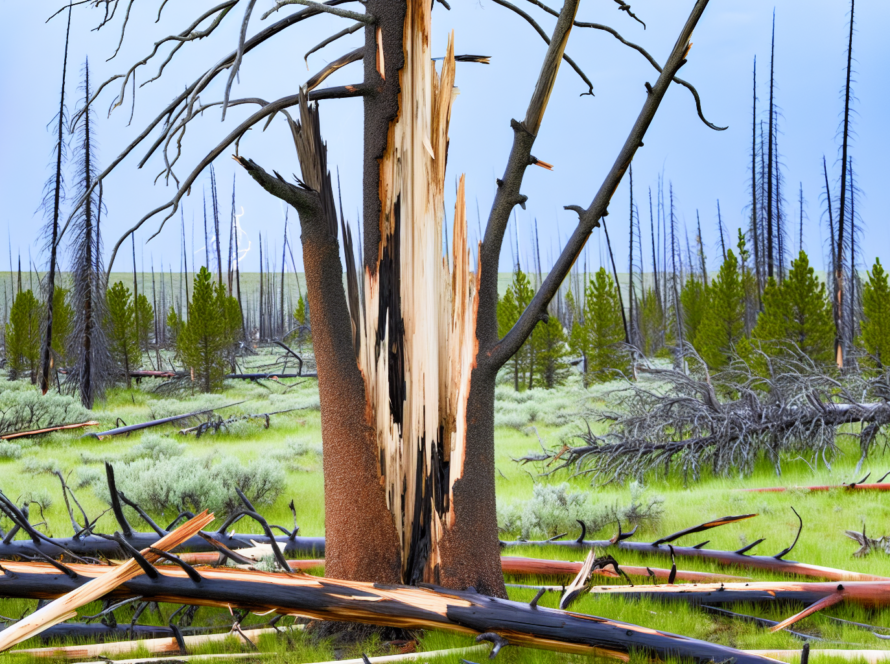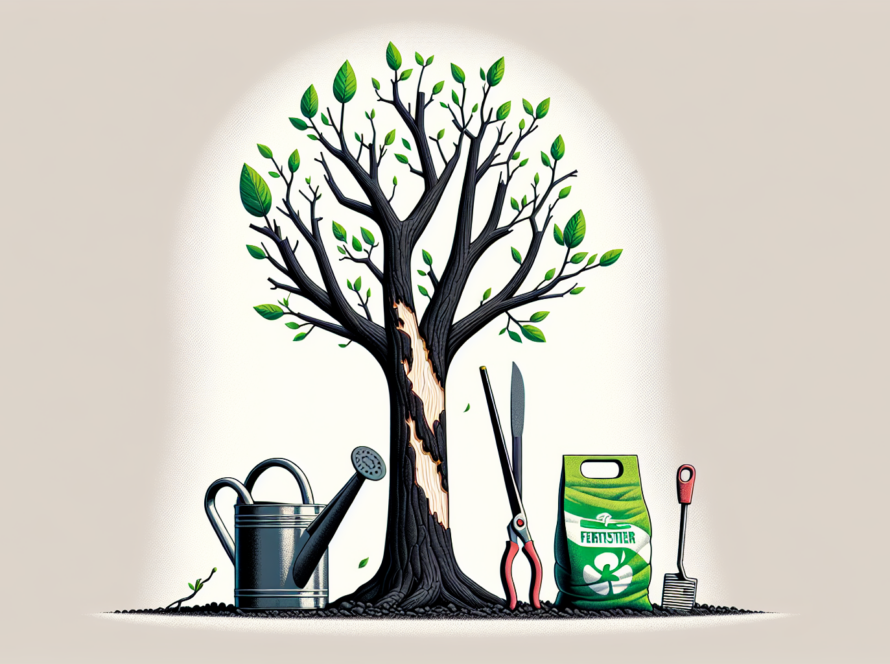If you are wondering about the best time to prune a tree, the simple answer is during the tree’s dormant season, typically between late winter to early spring. This period minimizes the impact on tree health and ensures rapid healing of pruning wounds, aligning with trees’ natural growth cycles. Read on to understand the specifics of why this timing works best and the exceptions based on different tree types and goals.
Key Takeaways
The best time to prune most trees is during their dormant stage, usually mid to late winter, to prevent disease and sap loss, catering to the tree’s natural healing cycle.
Different trees require pruning at various times of their growth cycle, such as early winter for deciduous trees, after blooming for flowering trees, and late winter for fruit trees to ensure optimal health and yields.
Effective pruning techniques and understanding when to seek professional help are key—use proper methods to encourage tree health and safety, and call experts for complicated or risky situations.
Understanding the Optimal Pruning Season
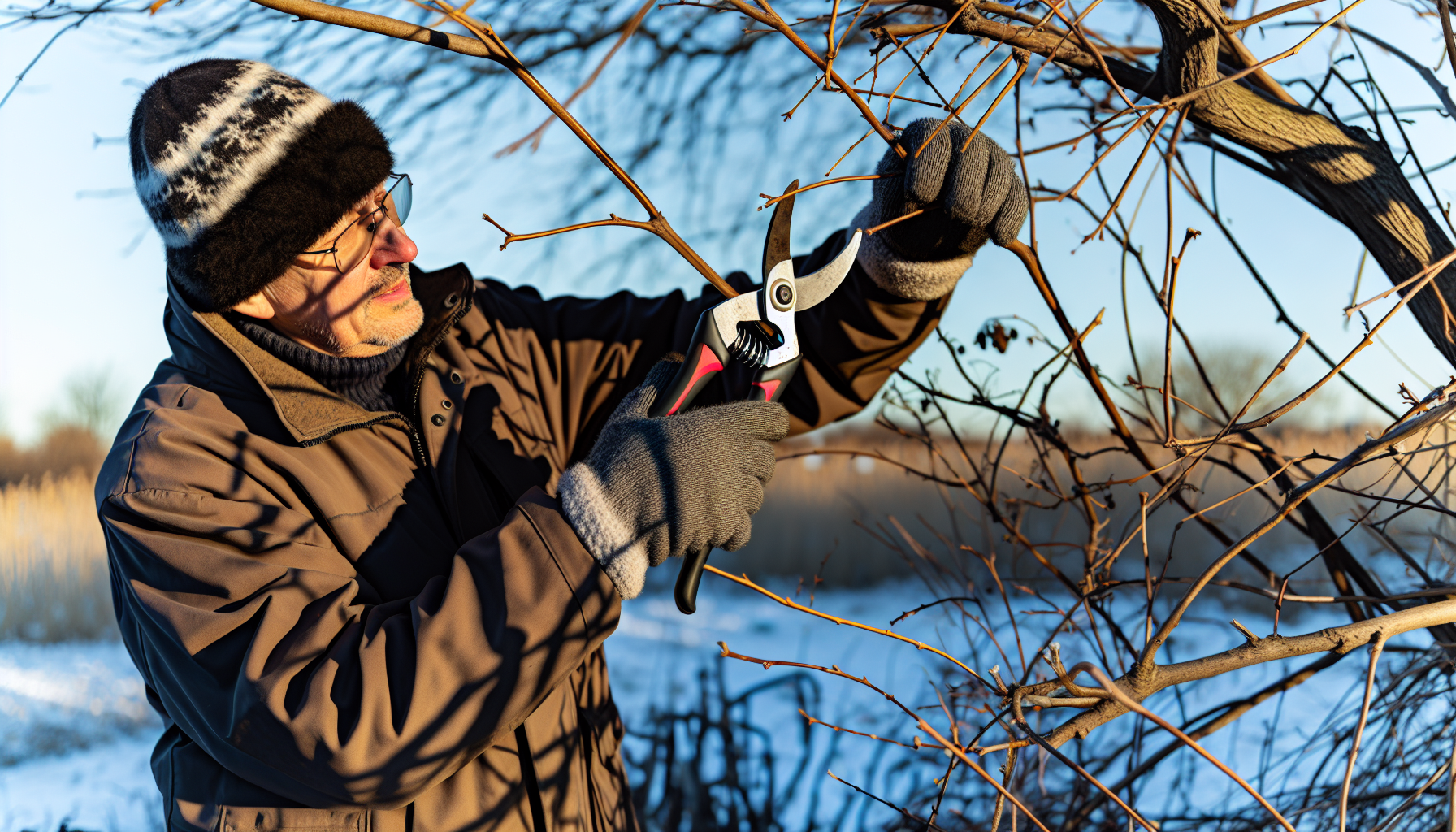
Picture this: it’s late winter, the crisp air hints at the coming spring, and your garden lies dormant. This serene period is not just a pause in nature’s rhythm—it’s the prime time for pruning trees. As trees focus on their internal healing processes during this dormant period, it becomes the most suitable time for pruning. The wounds from pruning cuts heal faster as the tree gears up for a burst of new growth, reducing the risk of diseases making a home in the fresh cuts. This timing aligns perfectly with the tree’s natural cycle, strengthening its structure and vitality for the upcoming growing season.
Yet, if you’ve ever sliced into a summer branch, you’ve seen the tree’s lifeblood—sap—weep from the wound. This loss doesn’t just tug at the heartstrings; it weakens the tree and invites a host of pests and diseases. Therefore, it’s recommended to conduct most pruning during the tree’s dormant stage, from mid to late winter, to avoid the susceptible blooming period. So, when the garden is quiet, and the trees stand still, reach for those pruning shears—it’s time to prune.
The Pruning Calendar: Tree Types and Their Ideal Times
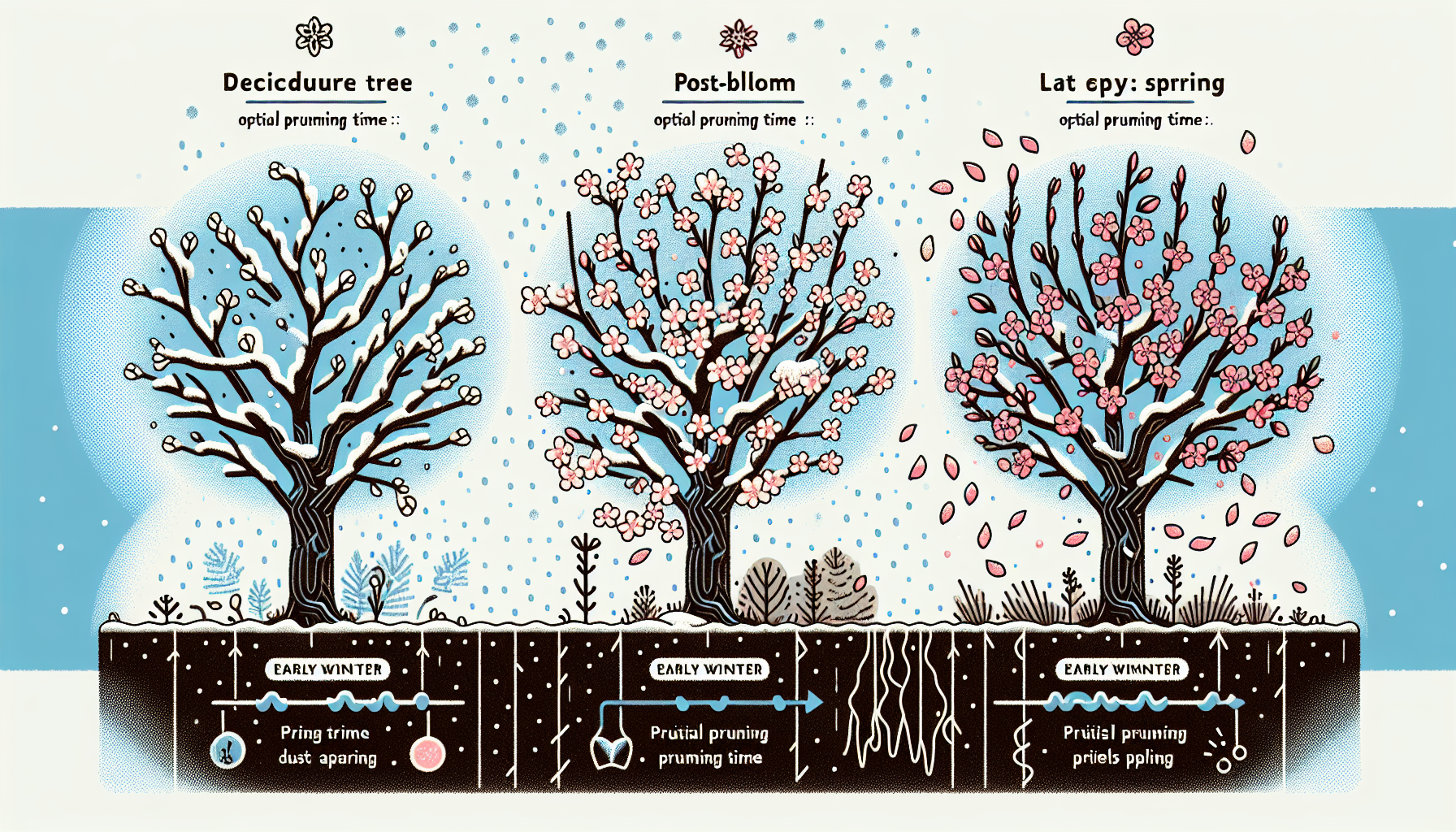
Just like us, trees have their own calendar of events, and for them, timing is everything. The ideal moment to prune a tree depends on its type and the desired outcome. From the majestic oaks to the humble apple trees, each has a season where pruning promotes their health and beauty. We will now delve into the pruning calendar to uncover the optimal times for making strategic cuts that foster lush canopies and abundant harvests.
Deciduous trees stand tall and proud in early winter, ready for their seasonal trim, while flowering trees wait patiently for their blossoms to fade before they’re ready for a post-bloom haircut. As for fruit trees, their pruning is timed to set the stage for a performance of abundant harvests. In each case, a well-timed prune can be the difference between a good year and a great one for your trees.
Deciduous Trees and Early Winter Pruning
Deciduous trees, with their leaves gone, reveal a natural architecture that’s easier to shape and support during the early winter months. This is when they’re most resilient, ready to withstand the pruning process with the least amount of stress, and prepare for a vibrant spring comeback. However, certain species, like maples, have a sap-filled surprise if pruned too early. Their tendency to “bleed” requires timing that balances between winter’s chill and the tree’s health.
Tree pruning, or the process to prune trees, in late winter or early spring paves the way for a season of unhindered growth, free from the constraints of dead or dying branches. It’s a time to:
strengthen the framework of young trees
rejuvenate the old giants
ensure that each branch, each twig, plays a role in the tree’s tale of survival and splendor.
Flowering Trees and Post-Bloom Care
The floral extravaganza of spring-blooming trees is one of nature’s most enchanting displays. But once the curtain falls on their blooming act, it’s time for some post-bloom care. These trees, which adorn themselves with flowers on old wood, benefit from a timely trim just as the last petals drift to the ground. This allows the tree to channel its energy into next year’s show without missing a beat.
Summer and fall bloomers, on the other hand, prefer their pruning in late winter or early spring, before they set the stage for their flowering finale. The crux is to prune at a time that doesn’t interfere with the delicate process of flower and fruit development, guaranteeing an abundance of aesthetics and produce in early summer.
Fruit Trees: Timing for Abundant Harvests
For homegrown fruit enthusiasts, the late winter to early spring season presents a vital window for pruning fruit trees. This timing not only sets the scene for an abundant harvest but also helps shape the tree for better sunlight exposure and air circulation. It’s like giving your fruit tree a personal trainer to ensure it’s in top shape for the growing season.
August to September, that’s when you might be tempted to give your fruit trees a little extra trim. But hold those pruning shears! Severe pruning during this period can do more harm than good. Instead, focus on light pruning that encourages the tree without stunting its development or reducing its yield.
Pruning Techniques for Tree Health and Aesthetics
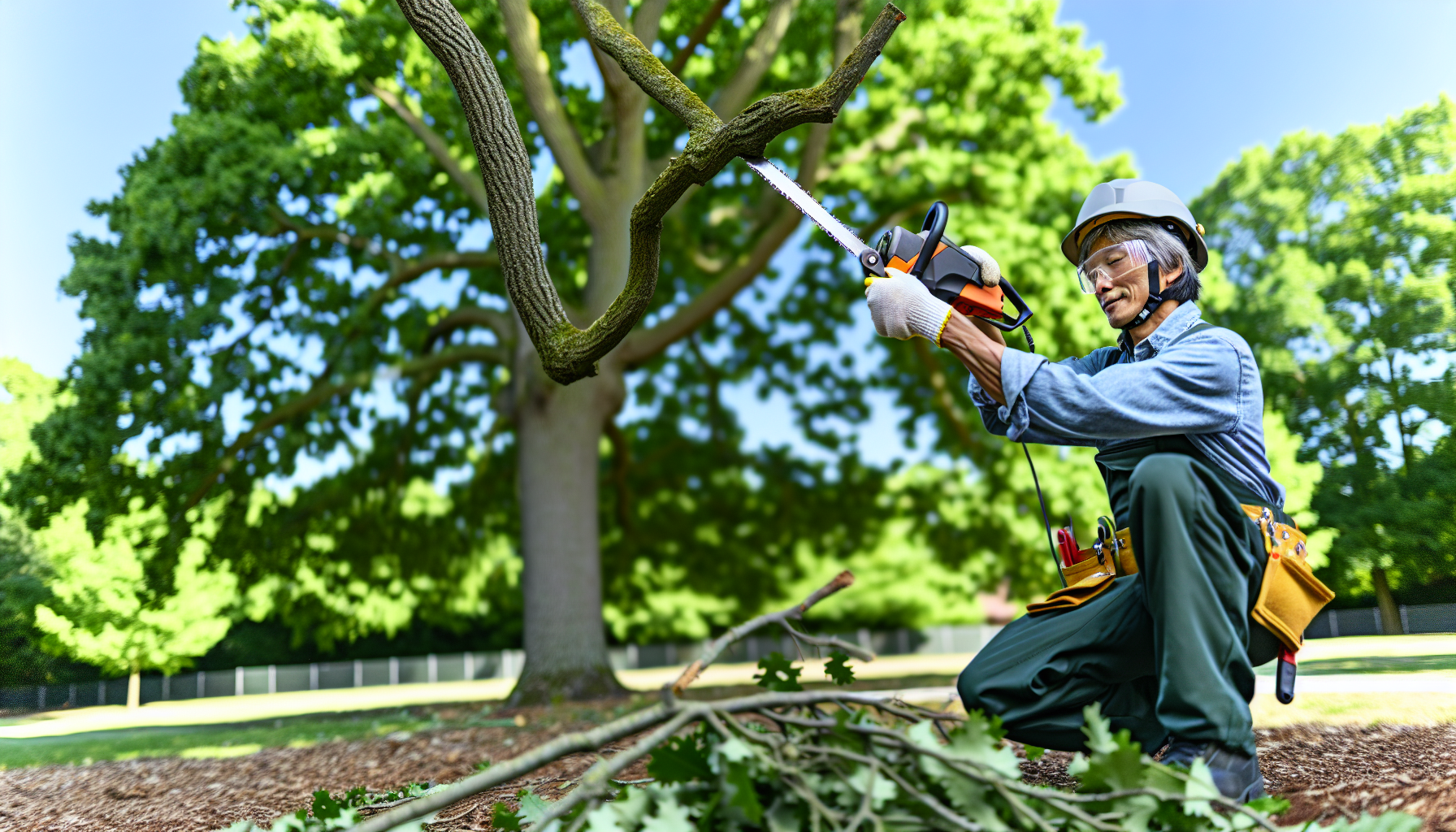
When it comes to pruning trees, it’s not just about removing what’s unwanted—it’s about enhancing what remains. Proper pruning techniques like thinning, raising, and reduction are the tools of the trade for any tree enthusiast aiming for both health and aesthetics. Unlike the brutal act of topping, which can leave a tree weak and vulnerable, selective pruning keeps the tree’s natural shape intact and builds a stronger, disease-resistant structure.
A meticulously pruned tree embodies a masterpiece of equilibrium and form. With each careful cut, we’re guiding the tree toward a future of robust growth and natural beauty. Making precise cuts at the branch collar stimulates quick callus formation, safeguarding the tree from environmental factors and preserving its desired shape. In tropical climates, special techniques like the three-cut method are especially useful for managing larger branches without causing trunk damage and encouraging the tree to heal properly.
Targeting Dead and Diseased Branches
The battle for a tree’s health often lies in its branches. Identifying and removing dead or diseased limbs is a crucial step in maintaining a robust tree. The cornerstone of a successful operation lies in the three-cut method, guaranteeing that the tree’s trunk remains intact and poised for healing. Diseased branches should be carefully removed below the affected area with precision to stop any further spread of decay.
Seasonal growth patterns are also a factor to consider. For instance, pruning deciduous trees during their dormant phase in late fall or early winter is ideal since it doesn’t interfere with cambial growth. Sanitizing tools before and after use on each tree is a best practice that cannot be overstated, as it significantly reduces the risk of disease transfer.
Remember, dead branches, diseased branches, and broken branches are not just an aesthetic issue but a safety concern, and sometimes they require the keen eye of a professional to manage effectively, especially when it comes to tree branches.
Encouraging New Growth and Form
Thinning a tree’s canopy is akin to drawing back curtains to let sunlight flood in. It amplifies light penetration and air movement, leading to more vigorous and healthy growth. Proper pruning techniques can indirectly stimulate the growth of lateral shoots, making for a fuller and more appealing plant. When you want to encourage branching, make your cuts just above a bud or branch facing the outside of the plant, directing new growth outward and maintaining good air circulation.
Shaping a tree or shrub is not only about health—it’s about setting a scene in the landscape. Whether you’re aiming for a dense hedge or a specific plant form, pruning is your creative tool to sculpt the living canvas of your garden. And let’s not forget the artistry that goes into maintaining formal shapes, such as the geometric precision of topiaries, which demands consistent and careful pruning to keep the design sharp and defined.
Special Considerations for Young and Mature Trees
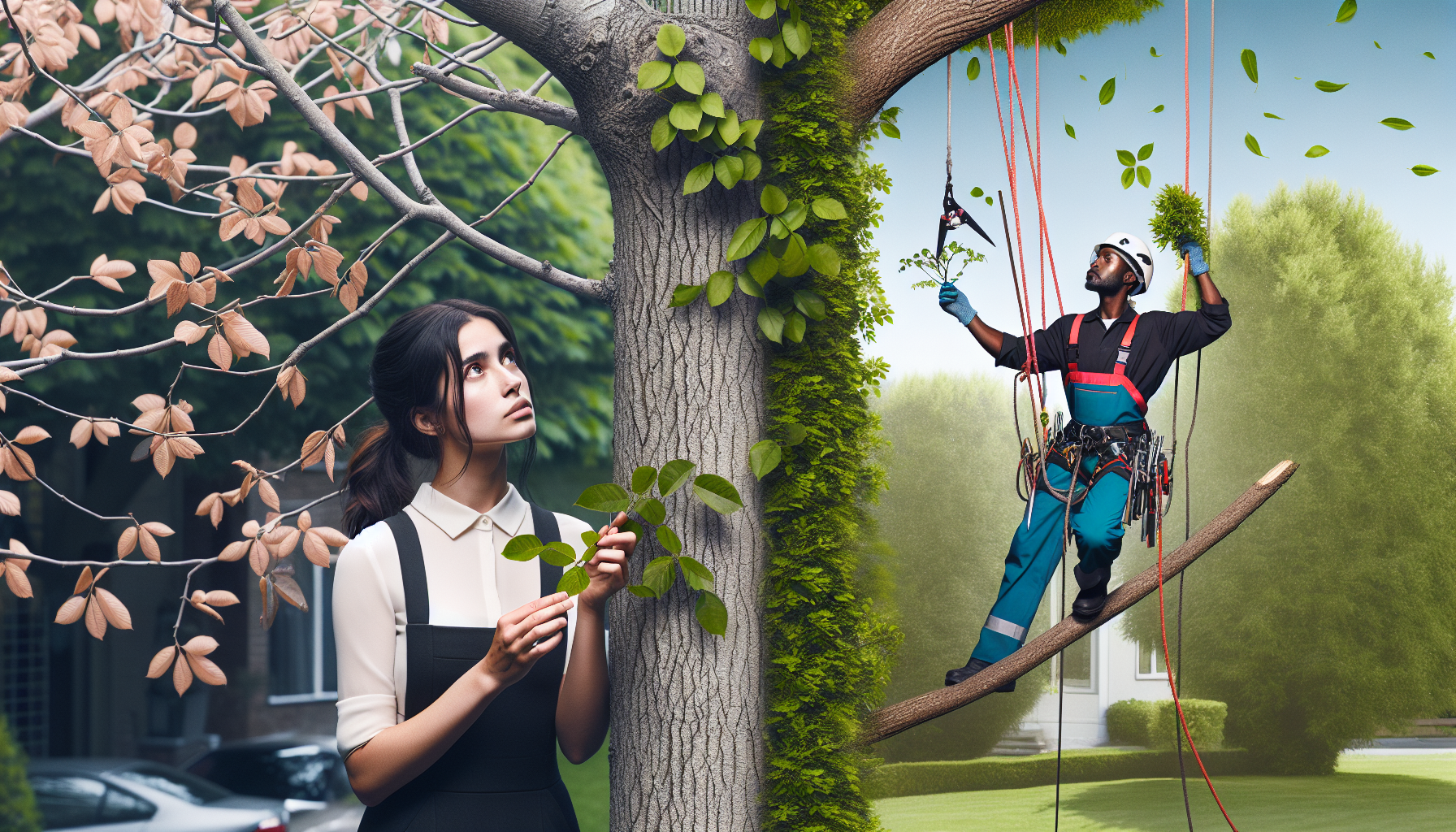
Every tree, whether it’s just starting out or has stood the test of time, has unique pruning needs. Young saplings need careful attention to build a strong foundation for the future, while mature trees require a different approach to maintain their grandeur and ensure their safety. It’s a delicate balancing act between nurturing growth and managing maturity, one that requires knowledge, patience, and sometimes a helping hand from experts.
For young trees, establishing a dominant leader and proper branch structure is a formative process that sets the stage for a lifetime of health and stability. On the other hand, mature trees may have acquired weak limbs over the years that need professional attention to prevent potential hazards. By considering the age and development stage of each tree, we can tailor our pruning approach to best support its growth and longevity.
Nurturing Young Trees with Initial Pruning
For young trees, consider initial pruning as their inaugural steps towards a robust and proportionate life. A strong central leader, good vertical spacing, and even radial branch distribution are the goals of this early stage of tree care. It’s about guiding the tree’s growth so that future branches don’t compete for the spotlight, ensuring a harmonious and stable structure.
While pruning can invigorate growth, it’s essential to understand that for young trees, especially, it may delay the start of their flowering and fruiting chapter. It’s also wise not to rush into pruning newly planted trees; give them at least a year to sink their roots into their new home before beginning structural pruning. Bear in mind, early pruning isn’t solely about eliminating branches—it’s about retaining those that will bolster the tree’s health and aesthetics in the long run.
Caring for Large Trees and Hazardous Situations
The majestic stature of large trees is awe-inspiring, but their maintenance shouldn’t be underestimated. These giants need an expert touch to remove weak limbs that could turn into dangerous projectiles during a storm. Regular and skilled pruning by professionals not only ensures their safety but also promotes a more vigorous and lush growth, keeping the tree in peak condition.
When faced with hazardous situations, such as large trees near power lines or with exposed root systems, it’s time to call in the cavalry—professional arborists equipped with the knowledge and tools to tackle the job safely. Not only is it a matter of personal safety, but also one of preserving the tree’s health and the property’s value. Sometimes, it’s best to leave the heroic acts to those trained for it.
DIY vs. Professional Pruning: What You Need to Know
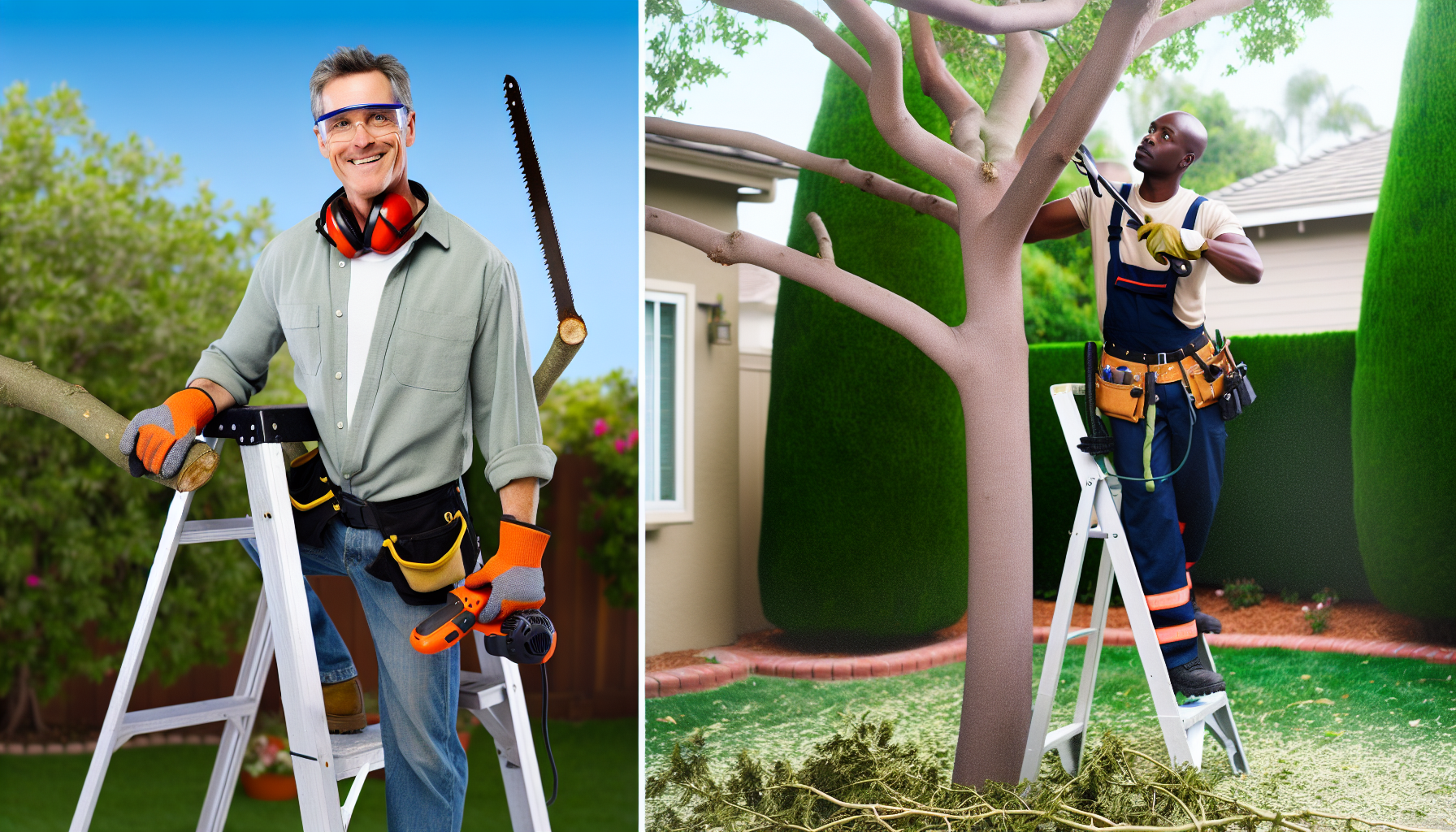
With the right tools and techniques, pruning your trees can turn into a gratifying DIY project. However, there are times when calling in the professionals is not only wise but necessary. Understanding the difference between what you can handle and what requires a seasoned arborist is key to ensuring the safety and health of both you and your trees. Let’s explore the essentials of home tree trimming and identify when expert help is the best course of action.
While there are times when the pruning job is simple enough for a weekend activity, other situations demand professional care due to their complexity and risk. Knowing when to wear the gardener’s hat and when to hand it over to the experts can make all the difference in the world to your trees’ wellbeing and your peace of mind.
The Basics of Home Tree Trimming
Taking on the role of a DIY pruner involves arming yourself with sharp, high-quality tree trimming tools such as:
Pruning shears to execute clean, healthy cuts
Fiskars loppers to cut through branches with precision
Extendable tools to reach higher branches without overexerting yourself
The proper pruning techniques you employ are essential; they prevent harm to the tree and set it up for a healthy future. Utilizing these tools will make your pruning tasks easier and more effective.
Safety is paramount in DIY tree trimming. Keep a safe distance from power lines, be aware of potential fall paths, and wear protective gear to prevent accidents. And after the pruning is done, don’t forget to give your tree a thorough watering to aid in its recovery and encourage robust growth.
Ultimately, the basics of home tree trimming are about being prepared, being safe, and being kind to your trees when you trim trees.
When to Enlist Expert Help
There are instances when the pruning task at hand calls for professional expertise. Large trees that tower over your home, branches that intertwine with power lines, or trees situated in challenging terrain—these are all scenarios where you’ll want to enlist the help of professional arborists or licensed tree trimmers. Their expertise is crucial not only for the safety of everyone involved but also to avoid any potential property damage.
Whether it’s a tree leaning precariously, an exposed root system, or the risk of falling branches, professional tree services are your go-to solution for mitigating risks and preserving the health of your landscape. If you’re ever in doubt about when to prune or how to handle complex pruning situations, don’t hesitate to seek expert advice—it’s their job to know trees inside and out and to ensure their care is handled with the utmost professionalism.
Seasonal Exceptions and Variations
Despite the general guidelines, a few exceptions always exist. In the world of trees, different climates mean different pruning schedules. In tropical climates, where the seasons are dominated by wet and dry periods, the dry season offers the perfect window for pruning. This is when wounds heal quickly, and trees are less susceptible to diseases that thrive in moisture. Conversely, pruning during the rainy season could open the door to unwanted infections.
Subtropical trees, with their more flexible constitutions, generally tolerate pruning throughout the year, offering more leeway in scheduling maintenance. However, certain deciduous trees like elms, maples, and birches can give us a sticky situation with sap bleeding if pruned during their growth phase in late winter or early spring—although, thankfully, this does not harm the tree. To prevent this, you might consider summer pruning for these species, or alternatively, prune them in late fall to avoid the sap flow spectacle altogether. It’s crucial to remember that pruning too late in the dormant season can impede a tree’s ability to close wounds, leaving it more vulnerable to pests and diseases.
Pruning for Specific Objectives
Pruning isn’t a universal solution; it can be customized to accomplish specific goals, contingent on your aspirations for your trees. For instance, if you’re aiming for show-stopping flower and fruit displays, you’ll want to remove non-beneficial fruiting structures to channel the tree’s energy into the most promising blooms and fruits. Thinning cuts do more than just improve plant form and health; they also increase light penetration and air circulation through the canopy, which is essential for vigorous growth.
Not to be overlooked is the role of pruning in maintaining the aesthetic of your landscape. Controlling the size and shape of your trees and shrubs can transform your garden’s appearance, turning it into a living work of art. Eliminating unwanted growth helps to maintain the clean lines and desired forms of your evergreens or other ornamental plants. Whether your goal is to enhance fruit production or to sculpt a garden masterpiece, the strategic use of pruning shears can make all the difference.
Summary
As we’ve explored the complex world of tree pruning, one thing is clear: the right cut at the right time can lead to a world of difference in the health and beauty of your trees. From the frosty calm of winter to the full bloom of spring, each season holds the key to a specific pruning practice. Whether you’re nurturing tender saplings or managing majestic oaks, remember that pruning is an art guided by nature’s rhythms. Now, armed with knowledge and shears, you’re ready to step into your garden and help your trees thrive.
Frequently Asked Questions
What are the 5 rules of pruning?
When pruning, remember to do it when the trees are dormant, follow the 1/3 rule, make appropriate cuts, maintain the correct height, and remove old, tired spurs. Also, make sure to prune back to a growing point and to remove problematic branches first. Regular pruning is important.
Is it OK to trim trees in the summer?
Yes, it is okay to trim trees in the summer, especially for structural cleanup like removing suckers, water-sprouts, crossed or rubbing branches, and dead, diseased, and damaged wood. Happy trimming!
What is the difference between tree trimming and pruning?
Tree pruning involves removing live, dead, diseased, and damaged branches for the tree’s health, while tree trimming focuses on cutting back branches that are causing interference. So, pruning is more about maintaining tree health, while trimming is about managing the tree’s size and shape.
Will pruning my flowering trees in summer harm them?
Pruning your flowering trees in summer may harm them, as they may bloom on old wood. It’s best to prune spring-blooming trees right after they flower to avoid any potential harm.
How do I know if my trees need professional pruning?
If you have large trees, trees near power lines, or trees in hazardous conditions, it’s best to hire professional arborists who have the expertise and equipment to handle complex pruning tasks safely. Avoid the risk and leave it to the pros.



